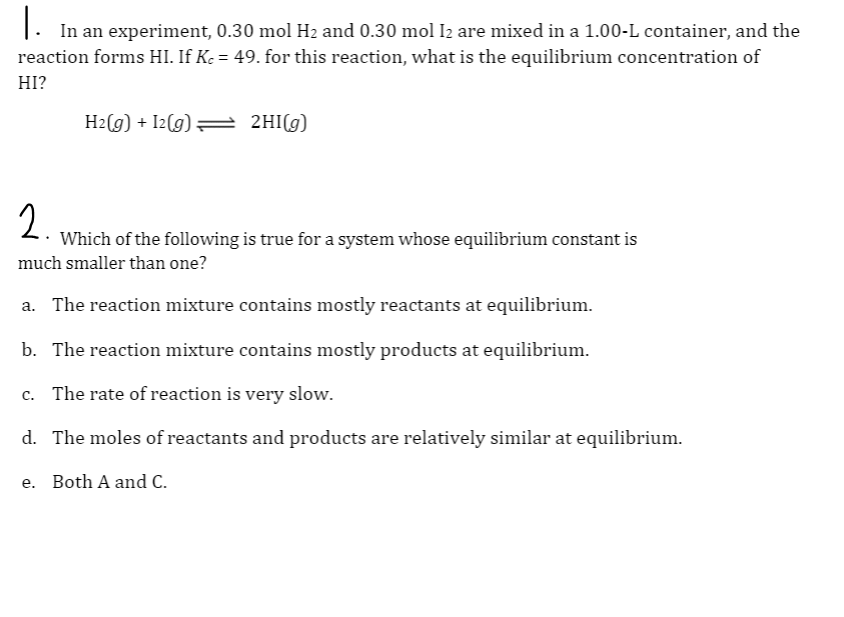1. In an experiment, 0.30 mol H2 and 0.30 mol I2 are mixed in a 1.00-L container, and the reaction forms HI. If Ke = 49. for this reaction, what is the equilibrium concentration of HI? H2(g) + I2(g)= = 2HI(g) 2. 2. Which of the following is true for a system whose equilibrium constant is much smaller than one? a. The reaction mixture contains mostly reactants at equilibrium. b. The reaction mixture contains mostly products at equilibrium. c. The rate of reaction is very slow. d. The moles of reactants and products are relatively similar at equilibrium. e. Both A and C.
1. In an experiment, 0.30 mol H2 and 0.30 mol I2 are mixed in a 1.00-L container, and the reaction forms HI. If Ke = 49. for this reaction, what is the equilibrium concentration of HI? H2(g) + I2(g)= = 2HI(g) 2. 2. Which of the following is true for a system whose equilibrium constant is much smaller than one? a. The reaction mixture contains mostly reactants at equilibrium. b. The reaction mixture contains mostly products at equilibrium. c. The rate of reaction is very slow. d. The moles of reactants and products are relatively similar at equilibrium. e. Both A and C.
Chemistry for Engineering Students
4th Edition
ISBN:9781337398909
Author:Lawrence S. Brown, Tom Holme
Publisher:Lawrence S. Brown, Tom Holme
Chapter12: Chemical Equilibrium
Section: Chapter Questions
Problem 12.41PAE: Because calcium carbonate is a sink for CO32- in a lake, the student in Exercise 12.39 decides to go...
Related questions
Question

Transcribed Image Text:1. In an experiment, 0.30 mol H2 and 0.30 mol I2 are mixed in a 1.00-L container, and the
reaction forms HI. If Ke = 49. for this reaction, what is the equilibrium concentration of
HI?
H2(g) + I2(g)=
= 2HI(g)
2.
2. Which of the following is true for a system whose equilibrium constant is
much smaller than one?
a. The reaction mixture contains mostly reactants at equilibrium.
b. The reaction mixture contains mostly products at equilibrium.
c. The rate of reaction is very slow.
d. The moles of reactants and products are relatively similar at equilibrium.
e. Both A and C.
Expert Solution
This question has been solved!
Explore an expertly crafted, step-by-step solution for a thorough understanding of key concepts.
This is a popular solution!
Trending now
This is a popular solution!
Step by step
Solved in 2 steps with 1 images

Knowledge Booster
Learn more about
Need a deep-dive on the concept behind this application? Look no further. Learn more about this topic, chemistry and related others by exploring similar questions and additional content below.Recommended textbooks for you

Chemistry for Engineering Students
Chemistry
ISBN:
9781337398909
Author:
Lawrence S. Brown, Tom Holme
Publisher:
Cengage Learning

World of Chemistry, 3rd edition
Chemistry
ISBN:
9781133109655
Author:
Steven S. Zumdahl, Susan L. Zumdahl, Donald J. DeCoste
Publisher:
Brooks / Cole / Cengage Learning

Chemistry
Chemistry
ISBN:
9781305957404
Author:
Steven S. Zumdahl, Susan A. Zumdahl, Donald J. DeCoste
Publisher:
Cengage Learning

Chemistry for Engineering Students
Chemistry
ISBN:
9781337398909
Author:
Lawrence S. Brown, Tom Holme
Publisher:
Cengage Learning

World of Chemistry, 3rd edition
Chemistry
ISBN:
9781133109655
Author:
Steven S. Zumdahl, Susan L. Zumdahl, Donald J. DeCoste
Publisher:
Brooks / Cole / Cengage Learning

Chemistry
Chemistry
ISBN:
9781305957404
Author:
Steven S. Zumdahl, Susan A. Zumdahl, Donald J. DeCoste
Publisher:
Cengage Learning


Chemistry: An Atoms First Approach
Chemistry
ISBN:
9781305079243
Author:
Steven S. Zumdahl, Susan A. Zumdahl
Publisher:
Cengage Learning

Chemistry: The Molecular Science
Chemistry
ISBN:
9781285199047
Author:
John W. Moore, Conrad L. Stanitski
Publisher:
Cengage Learning